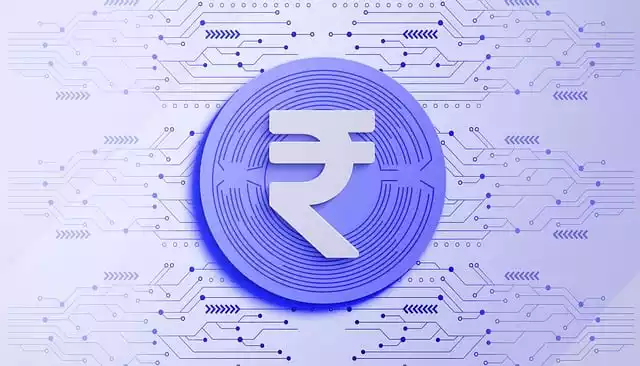Synopsis: Central Bank Digital Currency (CBDC), also known as digital fiat currency, is a digital representation of a country’s official currency issued by its central bank. It is a legal tender, just like physical cash, and holds the same value. In India, the CBDC is called the e-Rupee. It aims to complement and coexist with physical cash, offering a secure, convenient, and accessible alternative for making payments. Here we will discuss about what is CBDC or e-Rupee, how it works, benefits, etc.
Introduction We’re witnessing the dawn of a new era in the world of finance, where digital currencies are poised to become the norm. While cryptocurrencies like Bitcoin and Ethereum have gained significant traction, they’re not without their drawbacks, including volatility and regulatory uncertainty. Enter central bank digital currencies (CBDCs), a digital form of fiat currency issued by a central bank. India is among the countries actively exploring the potential of CBDCs, with its own digital currency, the e-rupee, currently undergoing pilot testing. In this blog post, we’ll delve into the world of CBDCs and the e-rupee, shedding light on what they are, how they work, and their potential impact on the future of finance.
What is a CBDC?
Central Bank Digital Currency (CBDC) refers to a form of digital currency issued by a country’s central bank. Unlike traditional physical currency, CBDC exists in electronic form and is designed to represent the national currency on a digital platform. This innovative financial instrument leverages the advancements in technology, particularly blockchain and distributed ledger technology, to provide a secure and efficient medium of exchange.
At its core, CBDC is a digital counterpart to a nation’s physical currency, such as coins and banknotes. However, it is distinct from cryptocurrencies like Bitcoin, as it is issued and regulated by a centralized authority—the central bank. This distinction ensures that CBDC retains the backing and stability associated with traditional fiat currencies.
One of the primary motivations behind the development of CBDC is to address the evolving landscape of payments and financial transactions. As digitalization transforms the way individuals and businesses conduct transactions, central banks seek to adapt by introducing a digital currency that aligns with the needs of the modern economy.
How Does a CBDC Work?
CBDCs can be designed in two main forms: retail and wholesale. Retail CBDCs are intended for use by consumers for everyday transactions, while wholesale CBDCs are designed for institutional use, such as interbank settlements. Retail CBDCs can be used through digital wallets, similar to how we currently use mobile payment apps.
Central Bank Digital Currencies (CBDCs) have emerged as a pivotal innovation in the financial realm, poised to reshape the way we interact with money. As these digital representations of fiat currencies gain traction, it’s crucial to understand the underlying mechanism that drives their operation.
The Core Structure of CBDCs
At the heart of CBDCs lies the concept of a central ledger, a secure database maintained by the central bank. This ledger serves as the authoritative record of all CBDC transactions, ensuring the integrity and immutability of the digital currency.
The Two Layers of CBDCs
CBDCs typically operate on a two-tiered system:
- The Wholesale Layer: This layer is primarily intended for large-value settlements between financial institutions. Central banks issue CBDCs to commercial banks, who then use them to settle interbank transactions.
- The Retail Layer: This layer targets everyday consumer use. Individuals can hold and use CBDCs for payments, much like physical cash or traditional bank deposits.
The Issuance and Distribution of CBDCs
Central banks are responsible for issuing CBDCs, similar to how they issue physical currency. They can either directly issue CBDCs to commercial banks or do so through intermediary institutions.
Commercial banks then distribute CBDCs to individuals through various channels, such as mobile wallets, payment cards, or direct deposit into bank accounts.
The Flow of CBDC Transactions
When an individual makes a payment using CBDCs, the transaction is recorded on the central ledger. This record verifies the transfer of ownership of CBDCs from the sender to the recipient, ensuring the validity and settlement of the transaction.
Security and Privacy Considerations
CBDCs are designed to be highly secure, employing advanced cryptographic techniques to protect against fraud and counterfeiting. However, balancing security with user privacy is a critical aspect of CBDC implementation.
Central banks need to strike a balance between maintaining transparency and accountability while protecting user privacy.
The Impact of CBDCs on Existing Systems
As Central Bank Digital Currencies (CBDCs) emerge as a revolutionary force in the financial landscape, their potential impact on existing systems is becoming increasingly apparent. While CBDCs hold immense promise for financial inclusion, efficiency, and stability, their introduction will undoubtedly necessitate adjustments and adaptations within the current financial framework.
- Redefining the Role of Commercial Banks: CBDCs are poised to reshape the traditional role of commercial banks by introducing a direct link between individuals and the central bank. This could potentially reduce the reliance on commercial banks for payment intermediation, altering their revenue streams and business models. Commercial banks may need to adapt their services and offerings to remain competitive in this evolving landscape, focusing on value-added services such as financial advice, wealth management, and risk management.
- Implications for Intermediaries and Payment Systems: The introduction of CBDCs could also impact intermediaries such as payment processors and remittance providers. These entities may need to adjust their operations to accommodate CBDCs and integrate them into their payment infrastructure. Existing payment systems may also undergo modifications to facilitate seamless integration with CBDCs. This could involve standardizing protocols and ensuring interoperability between different CBDC implementations.
- Rethinking Monetary Policy Frameworks: The emergence of CBDCs could necessitate a reevaluation of monetary policy frameworks. Central banks may need to develop new tools and strategies to effectively manage the money supply and influence economic activity in the presence of digital currencies. Policymakers will need to carefully consider the potential impact of CBDCs on monetary transmission mechanisms and ensure that their policies remain effective in managing inflation and promoting economic growth.
- Addressing Regulatory Challenges: The introduction of CBDCs poses significant regulatory challenges. Central banks and regulatory authorities will need to establish clear and comprehensive frameworks to address issues such as anti-money laundering (AML), combating the financing of terrorism (CFT), and consumer protection. These frameworks will need to strike a balance between enabling innovation and safeguarding financial stability and consumer interests.
- Adapting to the Evolving Financial Landscape: The advent of CBDCs signals a paradigm shift in the financial landscape, demanding adaptability and innovation from various stakeholders. Commercial banks, intermediaries, payment systems, and regulatory bodies will all need to adapt their operations and strategies to accommodate this new reality. Central banks will play a crucial role in guiding this transition, fostering collaboration among stakeholders, and establishing a framework that promotes financial inclusivity, efficiency, and stability in the era of CBDCs.
CBDCs hold immense promise for revolutionizing the financial landscape, but their introduction will undoubtedly necessitate adjustments within existing systems. Commercial banks, intermediaries, payment systems, and regulatory bodies will all need to adapt to this evolving landscape to ensure a smooth transition and reap the full benefits of this transformative innovation.
What is e-Rupee?

India has taken a bold step towards the future with the introduction of the e-Rupee, a digital form of the Indian rupee (INR). This innovative initiative is poised to revolutionize the way Indians make payments, enhance financial inclusion, and pave the way for a more secure and efficient digital economy.
The e-Rupee, also known as the Digital Rupee (e₹) or eINR, is a central bank digital currency (CBDC) issued by the Reserve Bank of India (RBI). It is a legal tender, just like physical cash, and is backed by the full faith and credit of the central bank. The e-Rupee exists in two forms:
- Wholesale CBDC (e₹-W): Primarily intended for use between financial institutions for large-value settlements.
- Retail CBDC (e₹-R): Designed for everyday consumer use, enabling individuals to make payments directly without the need for intermediaries.
Why is the e-Rupee Significant?
The introduction of the e-Rupee marks a significant milestone in India’s financial journey. It offers a plethora of potential benefits, including:
- Financial Inclusion: The e-Rupee can promote financial inclusion by providing access to digital payments for those without traditional bank accounts.
- Faster and Cheaper Payments: CBDCs can facilitate faster and cheaper cross-border payments, reducing transaction costs and improving efficiency.
- Enhanced Security: The e-Rupee can offer enhanced security compared to physical cash, reducing the risk of counterfeiting and theft.
- Financial Stability: CBDCs can potentially improve financial stability by providing central banks with greater control over the money supply.
- Retail Layer: Individuals can hold and use e₹-R for payments through mobile wallets, payment cards, or direct deposit into bank accounts.
Current Status and Future Outlook
CBDCs are still in their early stages of development, and their widespread adoption is likely to take time. However, the potential benefits they offer are driving central banks around the world to actively explore and experiment with CBDC initiatives.
As the technology matures and regulatory frameworks are established, CBDCs are poised to play a transformative role in shaping the future of money and revolutionizing the way we interact with financial services.
The e-Rupee is also in its pilot phase, with limited availability. However, the RBI is actively working towards expanding its reach and exploring its full potential.
The future of the e-Rupee holds immense promise for India’s financial landscape. It has the potential to revolutionize the way we make payments, enhance financial inclusion, and usher in a new era of digital finance.
End Note on What is CBDC or e-Rupee
As CBDCs gain traction worldwide, they pave the way for a future where digital transactions are not just commonplace but form the backbone of our financial ecosystem. The efficient, secure, and transparent nature of CBDC positions it as a transformative force, reshaping the way we perceive and engage with money.
In conclusion, As we explore the potential of CBDCs and the e-rupee, it is crucial to adopt a cautious and well-informed approach. Careful consideration of the challenges and opportunities is essential to ensure that the implementation of digital currencies is conducted with prudence, foresight, and a focus on long-term sustainability. By addressing the challenges and capitalizing on the opportunities, CBDCs and the e-rupee have the potential to revolutionize the financial landscape, fostering economic growth, promoting financial inclusion, and enhancing the efficiency and security of our financial systems.
FAQs – What is CBDC or e-Rupee
How to buy e-rupee in India?
There are currently four participating banks in India where you can purchase e-rupees. However, you will need to be selected for the Closed User Group (CUG) via SMS and email to participate in the digital rupee pilot programme. Once you have been selected, you can buy e-rupee.
Can E-rupee be used multiple times?
Yes, you can use the E-rupee vouchers multiple times.
How many types of digital rupee are there?
There are two types of digital rupee – Wholesale segment (e₹-W) and Retail digital Rupee (e₹-R).

